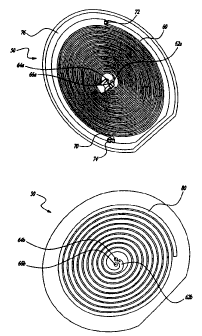Some of the information on this Web page has been provided by external sources. The Government of Canada is not responsible for the accuracy, reliability or currency of the information supplied by external sources. Users wishing to rely upon this information should consult directly with the source of the information. Content provided by external sources is not subject to official languages, privacy and accessibility requirements.
Any discrepancies in the text and image of the Claims and Abstract are due to differing posting times. Text of the Claims and Abstract are posted:
| (12) Patent: | (11) CA 2292635 |
|---|---|
| (54) English Title: | COMPACT SPIRAL ANTENNA |
| (54) French Title: | ANTENNE COMPACTE EN SPIRALE |
| Status: | Expired |
| (51) International Patent Classification (IPC): |
|
|---|---|
| (72) Inventors : |
|
| (73) Owners : |
|
| (71) Applicants : |
|
| (74) Agent: | SIM & MCBURNEY |
| (74) Associate agent: | |
| (45) Issued: | 2002-02-19 |
| (86) PCT Filing Date: | 1999-04-01 |
| (87) Open to Public Inspection: | 1999-10-14 |
| Examination requested: | 1999-12-02 |
| Availability of licence: | N/A |
| (25) Language of filing: | English |
| Patent Cooperation Treaty (PCT): | Yes |
|---|---|
| (86) PCT Filing Number: | PCT/US1999/007359 |
| (87) International Publication Number: | WO1999/052178 |
| (85) National Entry: | 1999-12-02 |
| (30) Application Priority Data: | ||||||
|---|---|---|---|---|---|---|
|
An antenna is provided that receives electromagnetic radiation and includes a
dielectric substrate (106). First and second spirals (60 and 70) on a first
surface of the substrate (106) radiate the electromagnetic radiation. A third
spiral (80) is utilized on a second surface of the substrate (106) and is
substantially underneath one of the first and second spirals (60 and 70). The
resulting spiral antenna is compact and has multioctave bandwidth capability.
L'invention concerne un antenne qui reçoit un rayonnement électromagnétique et comprend un substrat (106) diélectrique. Une première et une second spirale (60 et 70) disposées sur une première surface du substrat (106) diffusent le rayonnement électromagnétique. Une troisième spirale (80) est installée sur la seconde surface du substrat (106) et se trouve sensiblement sous la première ou sous la seconde spirale (60 et 70). L'antenne en spirale résultante est compacte et présente une capacité de fonctionnement sur une largeur de bande couvrant plusieurs octaves.
Note: Claims are shown in the official language in which they were submitted.
Note: Descriptions are shown in the official language in which they were submitted.

For a clearer understanding of the status of the application/patent presented on this page, the site Disclaimer , as well as the definitions for Patent , Administrative Status , Maintenance Fee and Payment History should be consulted.
| Title | Date |
|---|---|
| Forecasted Issue Date | 2002-02-19 |
| (86) PCT Filing Date | 1999-04-01 |
| (87) PCT Publication Date | 1999-10-14 |
| (85) National Entry | 1999-12-02 |
| Examination Requested | 1999-12-02 |
| (45) Issued | 2002-02-19 |
| Expired | 2019-04-01 |
There is no abandonment history.
| Fee Type | Anniversary Year | Due Date | Amount Paid | Paid Date |
|---|---|---|---|---|
| Request for Examination | $400.00 | 1999-12-02 | ||
| Registration of a document - section 124 | $100.00 | 1999-12-02 | ||
| Application Fee | $300.00 | 1999-12-02 | ||
| Maintenance Fee - Application - New Act | 2 | 2001-04-02 | $100.00 | 2001-03-22 |
| Expired 2019 - Filing an Amendment after allowance | $200.00 | 2001-10-16 | ||
| Final Fee | $300.00 | 2001-11-23 | ||
| Maintenance Fee - Patent - New Act | 3 | 2002-04-01 | $100.00 | 2002-03-13 |
| Maintenance Fee - Patent - New Act | 4 | 2003-04-01 | $100.00 | 2003-03-12 |
| Maintenance Fee - Patent - New Act | 5 | 2004-04-01 | $200.00 | 2004-03-15 |
| Maintenance Fee - Patent - New Act | 6 | 2005-04-01 | $200.00 | 2005-03-14 |
| Maintenance Fee - Patent - New Act | 7 | 2006-04-03 | $200.00 | 2006-03-15 |
| Maintenance Fee - Patent - New Act | 8 | 2007-04-02 | $200.00 | 2007-03-14 |
| Maintenance Fee - Patent - New Act | 9 | 2008-04-01 | $200.00 | 2008-03-17 |
| Maintenance Fee - Patent - New Act | 10 | 2009-04-01 | $250.00 | 2009-03-19 |
| Maintenance Fee - Patent - New Act | 11 | 2010-04-01 | $250.00 | 2010-03-23 |
| Maintenance Fee - Patent - New Act | 12 | 2011-04-01 | $250.00 | 2011-03-09 |
| Maintenance Fee - Patent - New Act | 13 | 2012-04-02 | $250.00 | 2012-03-14 |
| Maintenance Fee - Patent - New Act | 14 | 2013-04-02 | $250.00 | 2013-03-14 |
| Maintenance Fee - Patent - New Act | 15 | 2014-04-01 | $450.00 | 2014-03-12 |
| Maintenance Fee - Patent - New Act | 16 | 2015-04-01 | $450.00 | 2015-03-12 |
| Maintenance Fee - Patent - New Act | 17 | 2016-04-01 | $450.00 | 2016-03-09 |
| Maintenance Fee - Patent - New Act | 18 | 2017-04-03 | $450.00 | 2017-03-08 |
| Maintenance Fee - Patent - New Act | 19 | 2018-04-03 | $450.00 | 2018-03-07 |
Note: Records showing the ownership history in alphabetical order.
| Current Owners on Record |
|---|
| RAYTHEON COMPANY |
| Past Owners on Record |
|---|
| MEHEN, MIKE S. |
| SALVAIL, GARY |
| YU, I-PING |